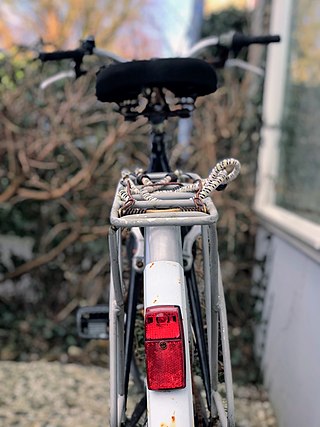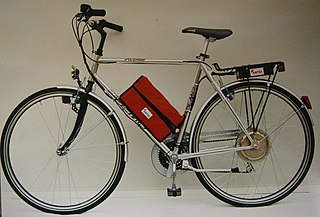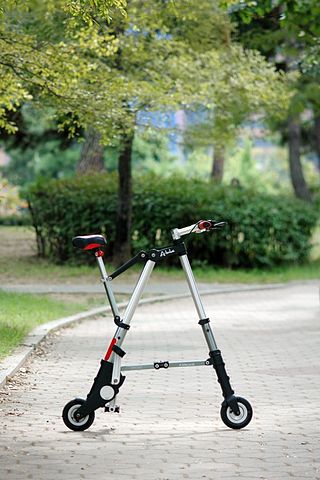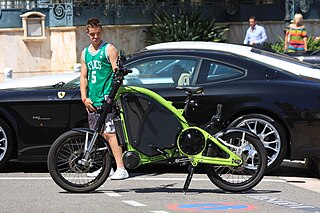
Sir Clive Marles Sinclair was an English entrepreneur and inventor, best known for being a pioneer in the computing industry and also as the founder of several companies that developed consumer electronics in the 1970s and early 1980s.

The Sinclair C5 is a small one-person battery electric recumbent tricycle, technically an "electrically assisted pedal cycle". It was the culmination of Sir Clive Sinclair's long-running interest in electric vehicles. Although widely described as an "electric car", Sinclair characterised it as a "vehicle, not a car".

The Twike is a human-electric hybrid vehicle (HEHV) designed to carry two passengers and cargo. Essentially a velomobile with an electrical hybrid engine, it can be driven in electric-only mode or electric + pedal power mode. Pedaling warms the user, making electric heating in winter unnecessary, extends the range of the vehicle but does not substantially add to the vehicle's top speed.
Sinclair Research Ltd is a former British consumer electronics company founded by Clive Sinclair in Cambridge. It was originally incorporated in 1973 as Westminster Mail Order Ltd, renamed Sinclair Instrument Ltd, then Science of Cambridge Ltd, then Sinclair Computers Ltd, and finally Sinclair Research Ltd. It remained dormant until 1976, when it was activated with the intention of continuing Sinclair's commercial work from his earlier company Sinclair Radionics, and adopted the name Sinclair Research in 1981.

Bicycle lighting is illumination attached to bicycles whose purpose above all is, along with reflectors, to improve the visibility of the bicycle and its rider to other road users under circumstances of poor ambient illumination. A secondary purpose is to illuminate reflective materials such as cat's eyes and traffic signs. A third purpose may be to illuminate the roadway so that the rider can see the way ahead. Serving the latter purposes require much more luminous flux and thus more power.

A motorized bicycle is a bicycle with an attached motor or engine and transmission used either to power the vehicle unassisted, or to assist with pedalling. Since it sometimes retains both pedals and a discrete connected drive for rider-powered propulsion, the motorized bicycle is in technical terms a true bicycle, albeit a power-assisted one. Typically they are incapable of speeds above 52 km/h (32 mph), however in recent years larger motors have been built, allowing bikes to reach speeds of upwards of 72 km/h.

An electric bicycle is a motorized bicycle with an integrated electric motor used to assist propulsion. Many kinds of e-bikes are available worldwide, but they generally fall into two broad categories: bikes that assist the rider's pedal-power and bikes that add a throttle, integrating moped-style functionality. Both retain the ability to be pedaled by the rider and are therefore not electric motorcycles. E-bikes use rechargeable batteries and typically are motor-powered up to 25 to 32 km/h. High-powered varieties can often travel more than 45 km/h (28 mph).
This timeline of motorized bicycle history is a summary of the major events in the development and use of motorized bicycles and tricycles, which are defined as pedal cycles with motor assistance but which can be powered by pedals alone.

The A-bike is a folding bicycle released by Sir Clive Sinclair in the United Kingdom on 12 July 2006. It was designed by Hong Kong design agency Daka, in collaboration with Sinclair Research, over a 5-year period. It was announced to the public in 2004. Clive Sinclair envisioned the A-bike, and Alex Kalogroulis was the main designer. It weighs 5.7 kilograms (13 lb) and folds to 67×30×16 centimetres (26.4×11.8×6.3 in), small enough to fit in a rucksack. The first version had 6-inch (15 cm) wheels, which was increased to 8 inches (20 cm) in later models. In 2015, an electric version, the A-Bike Electric, was introduced to the public as part of a Kickstarter campaign.

ZAP was an American company that specialized in electric vehicles of various types, such as cars, motorcycles, bicycles, scooters, watercraft, hovercraft, ATVs and commercial vehicles. Its name was an acronym for Zero Air Pollution. It was based in Santa Rosa, California, but it is no longer active. The last record of the company in the California Secretary of State business entity database shows that its agent for service of process resigned on October 26, 2016.

A pedelec or EPAC, is a type of low-powered electric bicycle where the rider's pedalling is assisted by a small electric motor. However, unlike some other types of e-bikes, pedelecs are classified as conventional bicycles in many countries by road authorities rather than as a type of electric moped. Pedelecs include an electronic controller which cuts power to the motor when the rider is not pedalling or when a certain speed – usually 25 km/h (16 mph) or 32 km/h (20 mph) – is reached. Pedelecs are useful for people who ride in hilly areas or in strong headwinds. While a pedelec can be any type of bicycle, a pedelec city bike is very common. A conventional bicycle can be converted to a pedelec with the addition of the necessary parts, e.g., motor, battery, etc.

Human power is work or energy that is produced from the human body. It can also refer to the power of a human. Power comes primarily from muscles, but body heat is also used to do work like warming shelters, food, or other humans.
The GreenWheel is a modular electronic assist device for bicycles that fits inside the wheel of any standard bicycle and provides additional power above and beyond the power provided by the person pedaling.

The eROCKIT is a light electric motorcycle that is operated like a bicycle. It is the first pedal controlled electric motorcycle, called Human Hybrid. In contrast to a pedelec, there is no direct mechanical energy transfer from the pedals to the rear wheel. The vehicle is developed and produced by eROCKIT Systems GmbH in Germany under the direction of the managing director Andreas Zurwehme. The design of the eROCKIT is done from Konstantinos Heyer.

A quadracycle is a four-wheeled human-powered land vehicle. It is also referred to as a quadricycle, quadcycle, pedal car or four-wheeled bicycle amongst other terms.

The Tidalforce Electric Bicycle was an electric bicycle manufactured by Wavecrest Labs from 2003 until the company went out of business in 2006. All models of Wavecrest Tidalforce electric bikes have a 36 volt electric hub motor built into the rear wheel hub and a 36 volt battery pack built into the front wheel hub. Wavecrest Labs manufactured three models of Tidalforce bikes: The Wavecrest Tidalforce M-750, the S-750 Traditional hard tail mountain bike and the iO-750 Cruiser. Any of the three bikes with an X suffix denotes that the motor is a 1000 watt motor without a set speed restriction as compared to the speed limit 750 watt version.

Johnson Matthey Battery Systems, part of the Johnson Matthey group and formerly called Axeon, designs and manufactures advanced lithium-ion battery systems for electric vehicles and processes over 70 million cells per year. Headquartered in Dundee, Scotland and with operations in Poland and sales offices in Coventry, England, Johnson Matthey Battery Systems produces batteries for all types of electric vehicles including urban delivery vehicles and high performance sports cars.

Bicycle drivetrain systems are used to transmit power on bicycles, tricycles, quadracycles, unicycles, or other human-powered vehicles from the riders to the drive wheels. Most also include some type of a mechanism to convert speed and torque via gear ratios.
Rubbee Drive is a 250W friction drive module which fits most standard bicycles. It enables a bicycle to reach up to 25 km/h speed and travel 40 km, making it a viable option for daily commuting. The units are assembled by JSC ELINTA in Lithuania.















